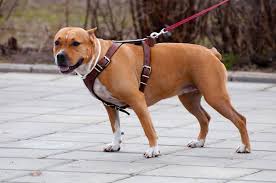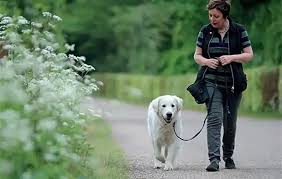
Going on walks with our pets has many benefits such as keeping us and our pets healthy, enjoying the beauties of nature and spending quality time with our best friends. But how do you keep your dog from pulling the entire walk or chasing after every squirrel they see? There are many different types of equipment that can be used on walks to help, and trust me, we’ve used them all! Your dog will still need to be trained to walk on a loose leash and will need help to become desensitized to triggers, but having the right equipment for the task will make things a lot easier on you, as they reduce the pulling power your dog has. Read on to see what each equipment type is meant for and their downfalls so you can choose what’s best for you and your pet.
Collars
Many believe their dog’s collar is meant to handle the pressure of their dog pulling on a walk. This is just not the case. Collars are best suited for displaying your dog’s identification information and that’s it. Here’s why:

· Flat or Rolled Collars
These collars are the most basic and can be found in a variety of materials. They are easy to find, affordable and are great for displaying ID tags and vaccination information. Many pet owners will often also use these basic collars to show their pet’s personality with different designs, bowties, bandanas and other accessories. However, unless your dog has been trained to walk nicely on leash, staying directly with you no matter what, these collars are not recommended for leash use. When dogs have a tendency to pull on leash, basic collars can cause major harm to your dog’s trachea as well as damaging pressure in your dog’s eyes.

· Prong & Choke Collars
Choke collars slip around a dog’s neck and tighten uncomfortably when the dog pulls against it, whereas prong collars are lined with blunt prongs that place pressure on the neck. When used correctly, these collars are intended only to get the dog’s attention, and not as a means of punishment. However, most do not put them on appropriately or use them in the manner intended, causing pain when the dog pulls. Because of this, we only condone their use under the supervision of a certified trainer after all other positive reinforcement training methods have failed and we do not recommend them for permanent use.

· Martingale Collars
These are a combination of a flat collar and a choke collar, designed with stops that make them less restrictive than choke collars and prevent them from restricting airflow. They are designed to sit high on the neck, avoiding the trachea and offer more control of the head, making your dog more responsive to directional changes. However, there are a lot of poorly designed Martingale style collars out there that tend to slip down and have the same issues as flat collars. Plus, if the collar is too big, it can slip over your dog’s head causing them to be loose. We recommend using these collars with the proper high neck placement only for dogs that are trained to walk nicely on leash whose heads and necks are the same or smaller circumference, like greyhounds that can easily back out of a standard flat collar.
Harnesses
A dog harness is a good tool because it distributes the weight and pressure from the leash away from your dog’s neck and onto their shoulders, chest and back. It is designed to prevent too much stress on any one part of the dog’s body, so the dog can move comfortably and safely. Here are the different types:
· Back Clip Harnesses

Harnesses with the D-ring for leash connection in the middle of the back are the most common. They are more comfortable than being walked on a collar and a common choice for brachycephalic breeds – flat faced pups like pugs – who are more prone to tracheal collapse. These are great if your dog constantly chews on their leash while out on walks, as the connector is behind their head, making it difficult for them to reach. This type of harness comes in Step-In and Over The Head options. Though they are better than collars, the location of the D ring on back clip harnesses encourages pulling behaviors, especially with breeds like Huskies which are bred to pull heavy objects. These harnesses are recommended for jogging, hiking or biking where comfort and freedom are the goals.
· Front Clip Harnesses

These harnesses have the leash connection at your dog’s chest and were designed specifically to discourage pulling. The front clip harness is a great choice for heavy pullers, especially for larger breeds. However, depending on the design and the fit, some chest harnesses shorten the dog’s stride and pulls them to the side which can be bad for their posture and musculature. You should consult a trainer to ensure the proper fit of a front clip harness. We recommend pairing this type of harness with a collar, connecting the leash to both at once, to increase your control, lessen the chance they can escape and make it easier to redirect your dog.
· Head Harnesses

Better known as a head halter, this harness is applied to the head and muzzle instead of the chest to give more control. The head halter loops over your dog’s muzzle just below the eyes. You then attach the leash below your dog’s chin. When your dog pulls, the harness puts pressure on the top of their muzzle, pulling their chin down or to the side. it looks similar to a muzzle, the head harness leaves enough space for your dog to drink water and bark. It is important to understand how to use head halters to prevent injury and get your dog to learn as quick as possible. The head halter is a great tool for dogs that constantly pull because they cannot put as much force into pulling their head as they can pulling with their entire body weight. It is also very useful for highly-active or hyper dogs, as they can be easily directed away from their trigger with a quick turn of the head. Since dogs instinctively follow their noses, controlling their head is the best way to get them to move in the direction that you want. But unfortunately, not all dogs can wear a head halter because of the shape of their skulls, such as the pug. Because of their flat faces and breathing difficulties the head halter is not suitable and won’t fit well.
It is important to note that no dog walking equipment teaches your dog not to pull on leash. All they do is reduce your dog’s pulling power. If your dog pulls, please consult a trainer for assistance so they can train you how to best handle and alter your dog’s behavior to what is most manageable for you both.
Walking is a great way to get exercise and bond with your pup, but knowing what gear is best to use while on walks is very important. Collars and harnesses each have their own benefits and problems, but figuring out what works best for you and your individual pup is key. It may take some trial and error before settling on the best solution, and we hope this article helps.
What is your preferred dog walking equipment? Why does it work best for you and your dog?





Leave a Reply